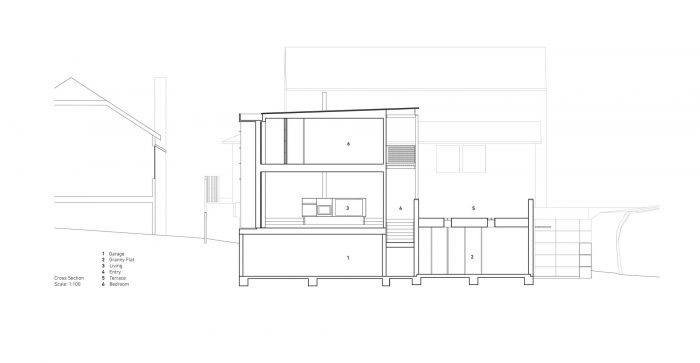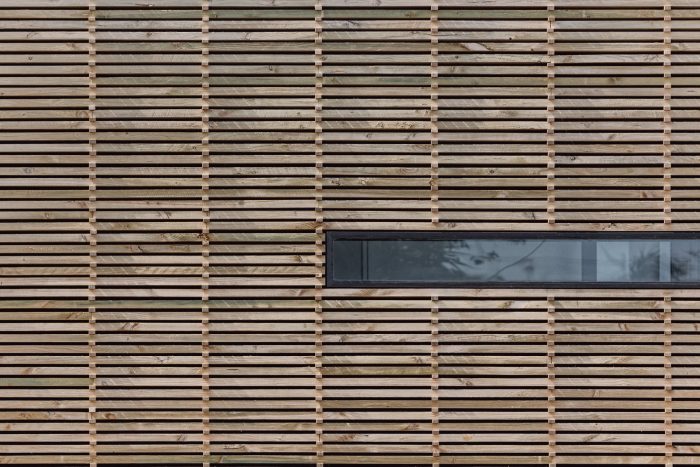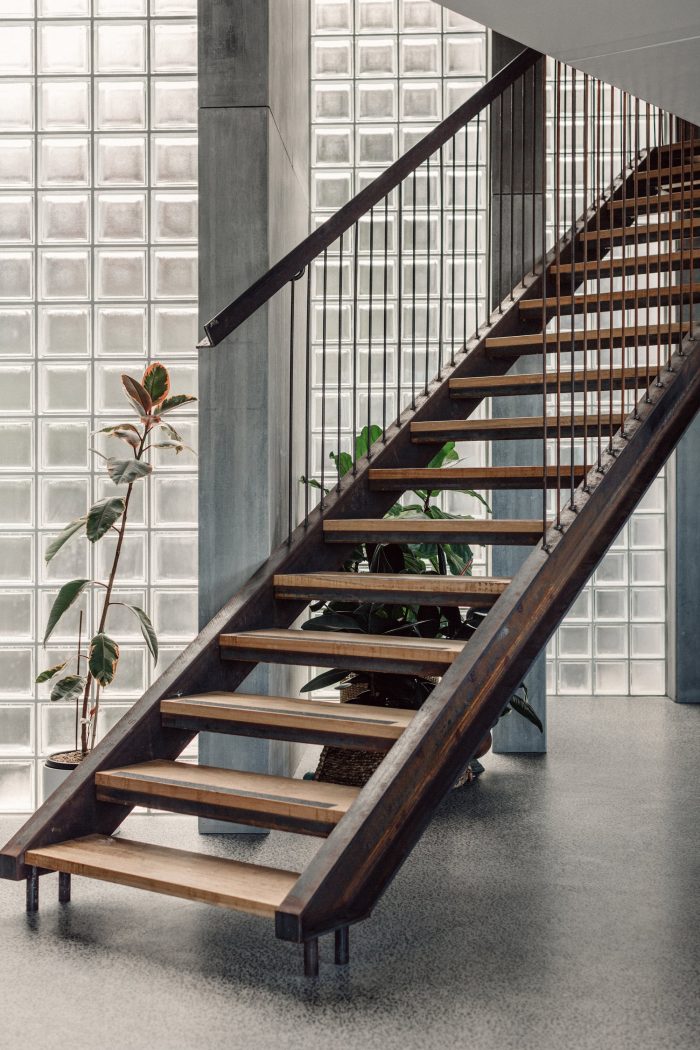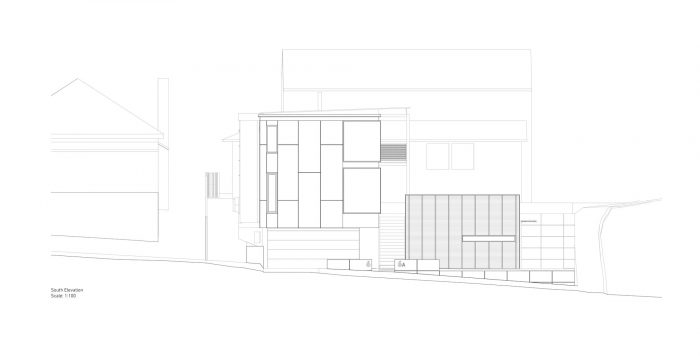在悬崖和大海之间。科利代尔位于伊拉瓦拉悬崖和太平洋之间,是一个正在经历温和转变的地区,那里的矿工小屋与更多的新式住宅交相辉映。该项目要求容纳一个富有创造力的四口之家,并提供一个较小的第二住所,以便与大家庭、朋友和客人分享这个美妙的地方。
Between Escarpment and the Sea. Coledale, located between the Illawarra Escarpment and the Pacific Ocean, is an area undergoing gentle transformation, where miner’s cottages jostle with more recent homes. The brief asked to accommodate a creative family of four and to provide a smaller second dwelling to share the wonderful locale with extended family, friends and guests.
这个项目建在一个受限的角落里,南面的陡峭斜坡、海景和太阳能接入都是相互矛盾的。作为回应,并从这一海岸线的地质层中汲取营养,开发了一个新的升高的地平面和高架平台,为居住者提供庇护和前景。在这之下,车库、储藏区和位于街角的第二个较小的住宅被容纳进来。在上面,坐落着主屋的较大体量,南北走向,创造了一个庭院,其东面朝向塔斯曼海。
This project is built on a constrained corner block, where a steep south facing slope, ocean views and solar access are all at odds with one another. In response, and drawing from the geological strata on this coastline, a new raised ground plane and elevated deck was developed, providing refuge and prospect for the occupants. Below this, the garage, storage areas and a second, smaller dwelling on the street corner are accommodated. Atop, sits the larger volume of the main house, running North – South, creating a courtyard with its eastern aspect toward the Tasman Sea.
通过透明阳台下的混凝土楼梯登上高处的平台,就像附近通过雨林的树冠登上悬崖一样。这个平台邀请景观进来,并欢迎社区;早上冲浪检查,向邻居随意挥手,日落时分喝酒。午后,人们在角落的窗户前阅读和看海。朋友们都会来这里。
Ascent to the elevated podium, via a concrete stair under the transparent balcony, is similar to nearby ascents up the escarpment through the canopy of the rainforest. This platform invites landscape in and welcomes community; for the morning surf check, a casual wave to neighbours and sunset drinks. Afternoons are spent in the corner windows, reading and watching the sea. Friends drop in.
在这里聚会是轻松的。坚固的材料接受沙子的脚和孩子们的玩耍。西面的立面由坚固的垂直叶片组成,向北倾斜以收集阳光并防止午后的热量,而东面的立面则引导视线,并通过透明的、种植的阳台过滤光线,形成与全天光线变化的紧密联系。该项目展示了一个双重用途的开发项目如何与其街道和景观位置密切相关,同时为两个住宅提供舒适性和隐私。
Gathering here is relaxed. Robust materials accept sandy feet and children playing. The West facade is composed of strong vertical blades, cranked to the North to collect sun and protect from afternoon heat, while the East facade guides views, and filters light through a transparent, planted verandah forming a close connection to changing light throughout the day. The project demonstrates how a dual occupancy development can relate intimately to its street and landscape location, while providing amenity and privacy for both dwellings.
从街上看,第二座较小的住宅,由于其堆叠的木材外墙而被称为Jenga House,作为独立的体量与住宅衔接,以打破规模,并使其能够以自己的个性站立。这些堆叠的木墙让人想起当地木材厂的干燥堆,以及附近海洋悬崖的侵蚀。它们的材料性是由对作为外部层的廉价粗锯松木的探索所驱动。
From the street, the second, smaller dwelling, called the Jenga House due to its stacked timber facade, is articulated as separate volume from the home, to break down scale, and to enable it to stand with its own personality. Those stacked timber walls recall drying stacks in local timber yards, and erosion in nearby ocean cliffs. Their materiality is driven by an exploration of cheaper rough-sawn pine as external layer.
主屋及其硬木围墙层与悬崖峭壁上的高大森林和峭壁有关,而其外壳则采用了无处不在的FC覆层。材料受到了景观和当地传统海滩房屋的影响。一个由当地制造商组成的团队使我们能够探索特定环境和业主所特有的材料和细节,而客户也是一个主要的贡献者。在想象项目的过程中,以及在承担大部分建筑工程的过程中,他们对项目的结果产生了巨大影响。
The main house and its layers of enclosure in hardwood relate to the tall forests and craggy cliffs of its escarpment backdrop, while its shell is sheeted in ubiquitous FC cladding. Materiality is influenced by both the landscape and the traditional local beach houses. A team of local makers enabled the exploration of materiality and detail specific to its particular environment and the owners, while the client was also a major contributor. In imagining the project, but also in taking on large parts of the building works they had a huge influence on the outcome.
细节设计是直接和简单的;而材料的选择则倾向于在所需的性能上尽可能地减少成本。基本的建筑材料被用作成品–如松木叠层墙和回收的混凝土景观墙。该项目以独特的方式利用了太阳能被动式设计原则,并力求在一个非常狭小的场地上最大限度地利用绿色空间。垂直立面和边界墙的设计是为了长期支持攀援的植物。
Detailing is direct and simple; and material choices prefer the least expensive possible for the required performance. Basic construction materials were used as finished products – such as pine stacked timber walls and recycled concrete landscaping walls. The project utilises solar passive design principles in a unique way and seeks to maximise green space on a very tight site. Vertical facades and boundary walls are designed to support climbing plants over time.
自然采光贯穿始终,适应性强的开口确保了需要时的交叉通风和减少能源足迹。诸如用混凝土厂的废料制成的再生混凝土块作为围墙等元素,进一步减少了占地面积。在悬崖峭壁下,靠近大海,这个新的住宅和次级住宅探索了景观、光线和社区感。
Natural lighting throughout, and adaptable openings ensure cross ventilation when needed and a reduced energy footprint. Elements such as recycled concrete blocks made of waste from the concrete plant as boundary walls further reduce footprint. Under the escarpment, close to the sea, this new home and secondary dwelling explores landscape, light and a sense of community.
Architects: Takt Studio
Area : 282 m²
Year : 2018
Photographs :Shantanu Starick
Manufacturers : GRAPHISOFT, James Hardie Australia, AHJ, ROGER SELLER, TOVO Lighting, TossB, CSR Barestone, Forest Furniture, Obeco – La Rochere, Paiano Custom Kitchens
Engineering : Northrop Engineers
Design Team : Brent Dunn, Katharina Hendel
City : Coledale
Country : Australia























